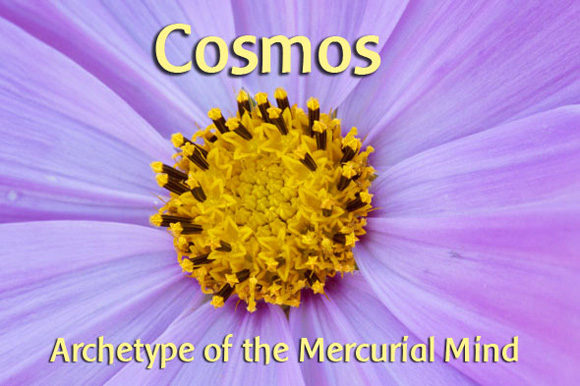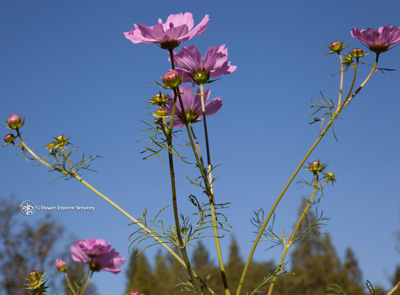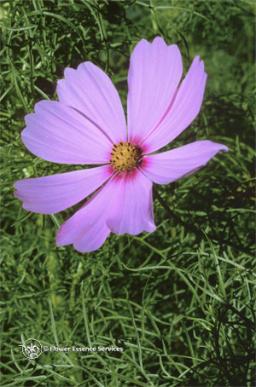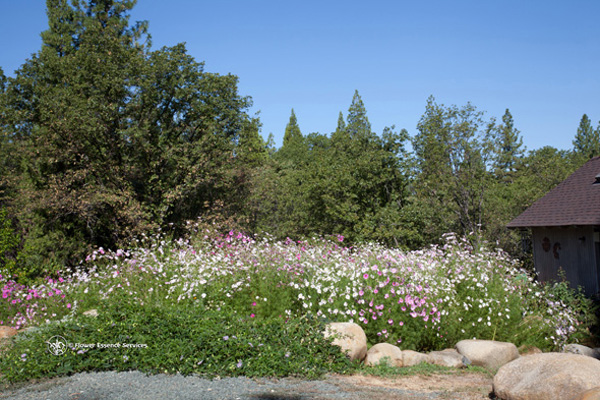
Family: (Traditional: Compositae), Sunflower/Aster/Daisy Family
English names: Cosmos, Mexican Aster
Habitat and growth pattern:

Cosmos is a subtropical annual that is easily adaptable to cultivation in many temperate climates. It prefers full sun, and will flourish in rich soil, extending its height up to 10 feet tall (3 meters) although more typically it grows 3-6 feet (1-2 meters).
 This plant grows rapidly from seed to flower, and continues to flower through the mid-spring into the summer or early autumn. The stems are tough, allowing for the vertical extension, with side branches in pairs extending at 45 degree angles. While highly structured, the plant has a flexibility about it, swaying in the wind.
This plant grows rapidly from seed to flower, and continues to flower through the mid-spring into the summer or early autumn. The stems are tough, allowing for the vertical extension, with side branches in pairs extending at 45 degree angles. While highly structured, the plant has a flexibility about it, swaying in the wind.The leaves are finely divided, feathery, and almost thread-like in appearance. The leaves appear in pairs, on opposite sides of the stems, and the leaf structure itself is made of branching pairs of thin leaflets on the mid-rib.
 The buds are spherical, sitting on a star-like base of eight involucre bracts. The flower heads, up to 4 inches (10 cm) across have bright yellow disk florets at the center, surrounded by the petal-like ray florets, which generally range in color from white to deep red, but more typically are various shades of pinkish magenta. The ray florets are generally eight in number and tend to curve upward slightly, forming a concave, or cup-like shape, pointed upward to the sky.
The buds are spherical, sitting on a star-like base of eight involucre bracts. The flower heads, up to 4 inches (10 cm) across have bright yellow disk florets at the center, surrounded by the petal-like ray florets, which generally range in color from white to deep red, but more typically are various shades of pinkish magenta. The ray florets are generally eight in number and tend to curve upward slightly, forming a concave, or cup-like shape, pointed upward to the sky.|
|
|
Name, History and Uses:
The botanical and common name Cosmos comes directly from the Greek kosmos, meaning order and harmony. The species name bipinnatus is Latin for “twice pinnate” referring to the pairs of branched leaflets that radiate from the central petiole, or leaf stem. The plant was named by Spanish priests in Mexico who began cultivating the plant in mission gardens. There are no known therapeutic uses for the plant, other than the flower essence.
Understanding the healing gesture of Cosmos essence:

Cosmos is a plant of the light and air. As a member of the Sunflower family it is exalted in the sun, and has the harmonious composite structure that gives it its genus and common name. But unlike the Sunflower plant, with its massive leaves, Cosmos leaves are airy, feathery, with long sinewy stems, which allow the plant to sensitively move with the wind. It does share the Sunflower’s solar orientation, with the flowers pointed upwards to the sun and the “cosmos.” Like other composite flowers, Cosmos is about integration of consciousness, allowing the many parts to speak as one whole.
 Thus, Cosmos is sensitive to its environment. It is also quick to adapt. It can spring back when moved around by a wind. And the plant itself has adapted to garden and wild environments far from its subtropical home. Cosmos is also quick, mercurial, growing rapidly from seed, then spreading in all directions, producing flower after flower, which quickly fade and are replaced by more flowers, spreading and proliferating. A community of Cosmos plants will exhibit all stages from buds to full flowers, fading flowers and seeds.
Thus, Cosmos is sensitive to its environment. It is also quick to adapt. It can spring back when moved around by a wind. And the plant itself has adapted to garden and wild environments far from its subtropical home. Cosmos is also quick, mercurial, growing rapidly from seed, then spreading in all directions, producing flower after flower, which quickly fade and are replaced by more flowers, spreading and proliferating. A community of Cosmos plants will exhibit all stages from buds to full flowers, fading flowers and seeds.
 Cosmos embodies many of the qualities attributed to the astrological sign of Gemini, the Twins. Not only is it quick and adaptable, sensitive to the currents of light and air, but there is a duality (twin-like quality) in the plant itself, in its bipinnate paired leaves. The act of dividing into discrete parts can be called “articulation,” a term also applied to clearly structured thought and speech.
Cosmos embodies many of the qualities attributed to the astrological sign of Gemini, the Twins. Not only is it quick and adaptable, sensitive to the currents of light and air, but there is a duality (twin-like quality) in the plant itself, in its bipinnate paired leaves. The act of dividing into discrete parts can be called “articulation,” a term also applied to clearly structured thought and speech.
The color of the Cosmos blossom is also significant, as the magenta colors indicate a vibrant presence of life force. Cosmos engenders enlivened thinking, an antidote to dry, abstract academic intellectualism or facile superficiality that characterizes much of contemporary thought.

 In so many ways, the Cosmos plant is the archetype of the awake mind: quick, agile, feather-light, yet ordered and bright. It is thus the perfect energy to help quicken the mind, and let thoughts flow freely and intelligently through our spoken word.
In so many ways, the Cosmos plant is the archetype of the awake mind: quick, agile, feather-light, yet ordered and bright. It is thus the perfect energy to help quicken the mind, and let thoughts flow freely and intelligently through our spoken word.
Key patterns of imbalance/indications: Unfocused, disorganized communication; overexcited speech, overwhelmed by too many ideas
Positive qualities: Integration of ideas and speech; coherent thinking; mercurial expression
Photography by Richard Katz
View a short video of a "Bee in the Cosmos" by Richard Katz:
View a delightful video of Cosmos blooming at Terra Flora, shot and edited by Alli Gallixsee:
Read an in-depth plant study of the Cosmos, written as part of the FES Certification Program, by flower essence practitioner Patricia Leslie.
The botanical and common name Cosmos comes directly from the Greek kosmos, meaning order and harmony. The species name bipinnatus is Latin for “twice pinnate” referring to the pairs of branched leaflets that radiate from the central petiole, or leaf stem. The plant was named by Spanish priests in Mexico who began cultivating the plant in mission gardens. There are no known therapeutic uses for the plant, other than the flower essence.
Understanding the healing gesture of Cosmos essence:

Cosmos is a plant of the light and air. As a member of the Sunflower family it is exalted in the sun, and has the harmonious composite structure that gives it its genus and common name. But unlike the Sunflower plant, with its massive leaves, Cosmos leaves are airy, feathery, with long sinewy stems, which allow the plant to sensitively move with the wind. It does share the Sunflower’s solar orientation, with the flowers pointed upwards to the sun and the “cosmos.” Like other composite flowers, Cosmos is about integration of consciousness, allowing the many parts to speak as one whole.
 Thus, Cosmos is sensitive to its environment. It is also quick to adapt. It can spring back when moved around by a wind. And the plant itself has adapted to garden and wild environments far from its subtropical home. Cosmos is also quick, mercurial, growing rapidly from seed, then spreading in all directions, producing flower after flower, which quickly fade and are replaced by more flowers, spreading and proliferating. A community of Cosmos plants will exhibit all stages from buds to full flowers, fading flowers and seeds.
Thus, Cosmos is sensitive to its environment. It is also quick to adapt. It can spring back when moved around by a wind. And the plant itself has adapted to garden and wild environments far from its subtropical home. Cosmos is also quick, mercurial, growing rapidly from seed, then spreading in all directions, producing flower after flower, which quickly fade and are replaced by more flowers, spreading and proliferating. A community of Cosmos plants will exhibit all stages from buds to full flowers, fading flowers and seeds. Cosmos embodies many of the qualities attributed to the astrological sign of Gemini, the Twins. Not only is it quick and adaptable, sensitive to the currents of light and air, but there is a duality (twin-like quality) in the plant itself, in its bipinnate paired leaves. The act of dividing into discrete parts can be called “articulation,” a term also applied to clearly structured thought and speech.
Cosmos embodies many of the qualities attributed to the astrological sign of Gemini, the Twins. Not only is it quick and adaptable, sensitive to the currents of light and air, but there is a duality (twin-like quality) in the plant itself, in its bipinnate paired leaves. The act of dividing into discrete parts can be called “articulation,” a term also applied to clearly structured thought and speech.The color of the Cosmos blossom is also significant, as the magenta colors indicate a vibrant presence of life force. Cosmos engenders enlivened thinking, an antidote to dry, abstract academic intellectualism or facile superficiality that characterizes much of contemporary thought.

 In so many ways, the Cosmos plant is the archetype of the awake mind: quick, agile, feather-light, yet ordered and bright. It is thus the perfect energy to help quicken the mind, and let thoughts flow freely and intelligently through our spoken word.
In so many ways, the Cosmos plant is the archetype of the awake mind: quick, agile, feather-light, yet ordered and bright. It is thus the perfect energy to help quicken the mind, and let thoughts flow freely and intelligently through our spoken word.Key patterns of imbalance/indications: Unfocused, disorganized communication; overexcited speech, overwhelmed by too many ideas
Positive qualities: Integration of ideas and speech; coherent thinking; mercurial expression
Photography by Richard Katz
View a short video of a "Bee in the Cosmos" by Richard Katz:

To install this Web App in your iPhone/iPad press ![]() and then Add to Home Screen.
and then Add to Home Screen.


